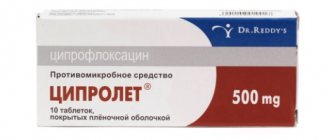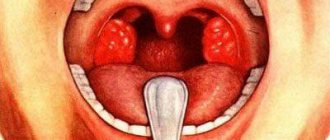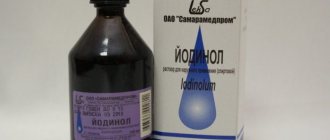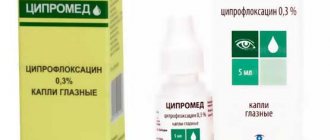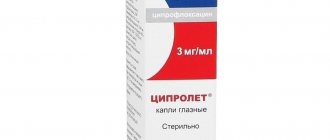Description of release forms and composition
The medicine is produced in three types:
- pills;
- eye drops 0.3% 5 ml;
- injection solution 0.2% 100 ml.
All medications contain ciprofloxacin (a group of fluoroquinolones). It has a wide antibacterial spectrum of action: it disrupts the proliferation of bacteria and prevents the spread of infection.
Additional components depend on the form of release; they allow the active substance to better penetrate into organs and tissues and act.
| Solution | Eye drops | Pills |
| Sodium chloride | Sodium chloride | Corn starch |
| Disodium edetate | Disodium edetate | Cellulose |
| Hydrochloric acid | Hydrochloric acid | Silicon dioxide |
| Water for injections | Water for injections | Talc |
| Lactic acid | Benzalkonium chloride | Magnesium stearate |
| Sodium hydroxide | ||
| Lemon acid |
Tablets are available in two dosages - 250 mg and 500 mg, 10 tablets each.
There is an additional form of the medicine - Tsiprolet A tablets. In addition to the antibacterial component, they contain tinidazole, which has an antimicrobial, antiprotozoal effect and enhances the properties of the first.
Price and analogues
There are many analogues of Tsiprolet. The following drugs are similar in composition: “Alox”, “Medociprin”, “Floximed”, “Ificipro”, “Ciloxan”, “Cipronate”, “Ciproxol”, “Cifran”, “Tsipromed”, “Ciprofloxacin”, “ Tsipropharm", "Tsiprol" and others.
As for the price, the medicine in question is not very high. Tablets of 500 mg can be purchased for 110 rubles (10 pcs.). The cost of eye drops and injection solution varies between 60-150 rubles.
Most reviews about the antibiotic "Tsiprolet" are positive. This drug helps treat many diseases. However, it should be remembered that it can only be taken in extreme cases.
Many patients leave negative reviews about this medication. As a rule, they are associated with the occurrence of side effects such as dizziness, weakness and difficulty breathing.
Indications for use of the antibiotic Tsiprolet
Instructions for use vary depending on the variety.
Tsiprolet 500 mg tablets, less often in smaller dosages, are taken for inflammation caused by an infectious process in the following organs and tissues:
- Airways;
- kidneys;
- urinary and reproductive system;
- ENT organs (ear, throat, nasopharynx, etc.);
- Gastrointestinal tract, including the dental system;
- biliary tract, gallbladder;
- skin, mucous membranes;
- bones and muscles.
The tablet form is also used for preventive purposes to reduce the likelihood of complications in patients with HIV and AIDS taking immunosuppressants.
For the same purposes, medicine is prescribed in the form of infusions and Tsiprolet A. They have a stronger anti-inflammatory and antibacterial effect.
Eye drops are used for the following eye diseases:
- inflammation of the mucous membrane (conjunctivitis);
- inflammatory process occurring in the edges of the eyelid (blepharitis);
- blepharoconjunctivitis;
- barley;
- ulcerative lesions of the cornea, keratitis and keratoconjunctivitis of a bacterial nature.
Additionally, installations of drops are used before and after surgical interventions, to prevent the development of complicated conditions, after injuries, and in case of a welding burn to the cornea.
Is Tsiprolet an antibiotic?
So is “Tsiprolet” an antibiotic or not?
There is no answer to this question. Although it is a chemical substance, it has the most pronounced bacteriostatic activity, affecting a wide variety of microbial agents. It is surprising that this drug has been used for a long time. It was created in 2007 and has not yet lost its popularity due to its good antimicrobial activity, availability and minimum side effects. “Tsiprolet” is used in any field of medicine. What group of antibiotics is represented by this drug, without which not a single home medicine cabinet is complete? This drug belongs to the group of fluoroquinolones. This group, like all antibiotics, has a destructive effect on the bacterial cell. The active ingredient of "Tsiprolet" and its analogues is ciprofloxacin, which, when it enters the bacterial body, destroys the DNA enzyme, which leads to a stop in the synthesis of cellular proteins, and kills both adult microorganisms and those that are in the reproduction stage. Resistance or resistance to the drug "Tsiprolet 500" is quite rarely observed. Antibiotic or not, it doesn't matter that much. Its excellent therapeutic effect does not diminish depending on what it is correctly called and which group it belongs to. The free penetration of a medicinal substance into the cell, which is not stopped by either the enzymes or the bacterium itself, leads to the fact that DNA synthesis is impossible, the cell stops and stops dividing. And at the same time, irreversible processes occur in the nucleus, cytoplasm and shell: the microorganism dies.
Instructions for use and dosage
Eye drops are used 1-2 drops every 2-4 hours depending on the severity of the disease. After symptoms decrease, reduce the frequency of instillation. The course of treatment is determined by the ophthalmologist depending on the disease and its course, and ranges from 5 to 7 days on average.
Tablets are produced in two dosages - 250 mg and 500 mg. The second is used for the normal course of diseases and complications. A medicine with a lower dose is the drug of choice for patients with low weight and kidney disease (chronic failure). The medication is taken one tablet twice a day, the course of treatment is determined individually. On average it ranges from 7 to 10 days.
The tablets should be taken on an empty stomach and washed down with a glass of clean water.
The solution for infusion is administered dropwise, slowly, twice a day, possibly in combination with a solution of sodium chloride or dextrose. Treatment is carried out in a hospital under the supervision of specialists.
Mode of application
Tsiprolet in tablet form: Prescribed to patients over 15 years of age.
- Uncomplicated infectious diseases of the genitourinary system - 250 mg;
- Infectious diseases of the lower respiratory tract - 250-500 mg;
- Complications of infectious diseases of the genitourinary system or prostatitis - 500 mg;
- Infectious diseases of the musculoskeletal system and infectious diseases of the ENT organs - 500-750 mg;
- Infectious diseases of the female genitourinary system - 500 mg;
- For acute intestinal infections - 500 mg;
- For the treatment of gastroenteritis - 250 mg;
- General infectious diseases and sepsis - 500-750 mg, initially by intravenous infusion, and then in tablet form.
When taking the drug Tsiprolet in the form of a solution for intravenous infusion: It is administered over a period of half an hour to an hour.
- Infectious diseases of the respiratory system - 200 mg;
- Uncomplicated infectious processes of the genitourinary system - 100 mg;
- Complicated or severe infectious diseases of the genitourinary system - 200;
- Other infectious diseases - 200 mg;
- For the treatment of uncomplicated gonorrhea - 100 mg once.
Ciprolet in the form of eye drops:
- Mild to moderately severe infection - 2 drops every 4 hours;
- Severe infection - 2 drops every hour.
local application of Tsiprolet
Drug interactions and compatibility with alcohol
During therapy with any type of Tsiprolet, it is necessary to exclude alcohol and ethanol-containing liquids.
When the drug is co-administered with the following groups of drugs, reactions are observed:
- with didanosine – the absorption of the antibiotic decreases and its effectiveness is lost;
- with theophylline – the toxic effect of the drug against shortness of breath and bronchial asthma increases;
- with antacids (Almagel, Maalox, Phosphalugel, etc.) – the absorption of the antibacterial drug is reduced, so two medications should be used with a minimum time difference of 4 hours;
- with anticoagulants - the risk of bleeding and prolongation of its duration;
- with cyclosporine - negative effects on the kidneys.
Strengthening or weakening the effect of “ciprolet”
If drugs that reduce the pH of gastric juice are used together with Ciprolet, the absorption of ciprofloxacin will decrease. The same thing happens when using iron-, magnesium-, zinc-, and aluminum-containing drugs together.
We suggest you read: How to use miramistin for the throat of children
Non-steroidal anti-inflammatory drugs and Tsiprolet increase the likelihood of seizure activity.
"Tsiprolet" and "Ciclosporin" increase the adverse effect on the kidneys.
Ciprofloxacin potentiates the effect of Warfarin, and theophylline slows down the elimination process of Ciprolet.
The drug combines well with other antibiotics: the effect of each is enhanced.
Contraindications, side effects and overdose
Prescription restrictions depend on the form of release.
Common to all types are:
- individual intolerance;
- pregnancy, breastfeeding;
- pseudomembranous colitis;
- age up to 18 years, except for eye drops, which can be used from one year onwards.
The combined antibiotic Tsiprolet A has additional contraindications: diseases of the central nervous system, blood and hematopoietic organs. It contains tizanidine, so in order to prevent overdose and unwanted side reactions, you should not additionally use products that contain this substance.
Tsiprolet eye drops cannot be used for viral keratitis.
The severity of adverse reactions depends on the form of the medication, compliance with recommendations, and the individual characteristics of the patient. Eye drops are used topically; when instilled, blurred vision, allergic manifestations at the site of contact, double vision and temporary changes in color perception are possible.
After using other forms, nausea, vomiting, stomach pain, dyspepsia, jaundice, headache and dizziness, sweating, impaired taste and smell, tinnitus, rapid heart rate, decreased blood pressure and a feeling of hot flashes, allergic manifestations are possible.
There is no information about an overdose of eye drops used according to the instructions. In case of intentional or accidental internal use, it is necessary to rinse the stomach and take adsorbing medications (activated carbon, Polysorb, Enterosgel, Polyphepan, Filtrum-Sti, Enterodes).
When using doses of tablets and infusions higher than the maximum, overdose symptoms are possible: convulsions, reversible disorders of the urinary system. There is no special antidote for treatment. It is necessary to rinse the stomach, use symptomatic therapy (for fever, pain) and give the patient a sufficient amount of clean water. If necessary, visit a specialist.
pharmachologic effect
Ciprofloxacin has a bactericidal effect. The main effect is the suppression of the activity of intranuclear bacterial DNA gyrase, which initiates the process of synthesizing messenger RNA from a DNA molecule. This leads to the impossibility of further reproduction and maintenance of vital activity by the bacterium.
Tsiprolet is active against many microorganisms. It actively fights gram-positive and gram-negative bacteria. the drug does not have a toxic effect on the human body due to the fact that there is no DNA gyrase in our cells (we are talking about cases with a correctly selected dosage).
Tsiprolet for sinusitis is an extremely effective remedy and is often used when resistance to other drugs is detected! Today it is used when aminoglycosides, penicillins and other antibiotics are ineffective.
Release forms
The pharmaceutical industry has created many forms of drugs; such a wide choice is associated with solving a number of problems, including:
- ease of administration;
- painlessness;
- possibility of precise dosing of the drug;
- safety for humans.
In pharmacies in our country you will find Tsiprolet in the form of tablets, injection solution or in the form of eye drops. The tablet form of release is the most convenient, which explains the wide choice of dosages: 250 mg, 500 mg, 1000 mg (rarely). The leader in the production of this drug is Italy.
Solution for injection in dosage (based on the active substance) - 2 mg/ml.
The drug is administered both intramuscularly and intravenously, but the latter option should only be performed in a hospital setting, as there is a high risk of developing allergic reactions.
Despite the fact that the parenteral route of administration of the drug has a greater therapeutic effect, it should only be performed as prescribed by a doctor.
Remember that taking antibacterial agents should only be started after being prescribed by your doctor, as otherwise there are high risks to life and health!
How to take for various forms of sinusitis?
Today, there is a single recognized regimen for taking Tsiprolet for sinusitis, but many doctors prefer to adjust the dosage depending on the therapeutic effect. So, for upper respiratory tract infections, the group of which includes sinusitis, Tsiprolet is prescribed in a volume of 250 - 500 mg twice a day.
Thus, the maximum daily dosage is no more than one gram of the active substance. When taking it, carefully check the dosage indicated on the blister in order to correctly select the required number of tablets.
In severe forms of pneumonia or sinusitis, it is allowed to increase the maximum daily dose to 1.5 grams, but it is taken 750 mg twice a day.
Remember that this volume of therapy can cause unforeseen complications, so it is prescribed and taken only with the constant supervision of medical personnel in a 24-hour hospital setting.
Use of the drug in children
If a parent decides to use Tsiprolet for the treatment of sinusitis in children, then it should be remembered that the need to take antibacterial drugs should be decided by a pediatrician or otolaryngologist. The maximum dose is 500 - 750 milligrams per day. It is considered more correct to calculate the daily dosage depending on the child’s body weight: 30 mg/kg.
Due to the fact that the child’s body is more prone to allergic reactions, in the case of the first dose, continuous monitoring of the child for 3-5 hours is recommended, as there is a risk of developing:
- hives;
- laryngeal stenosis;
- anaphylactic shock.
In some cases, the reaction can take on a purely individual character.
If you begin to notice such manifestations, then you should immediately give the child antihistamines, which will reduce the basophilic activity of mast cells, and then immediately contact your local pediatrician. If airway stenosis or shock develops, you must immediately call an emergency medical team.
To date, there has been a complete ban on the use of Ciprolet, as well as all products containing ciprofloxacin by pregnant women. The active substance is able to penetrate the hemoplacental barrier and affect the development of the fetus. Taking ciprofloxacin (as well as fluoroquinolones in general) in the first trimester is especially dangerous, as the risk of developing congenital anomalies increases.
A similar ban applies to nursing mothers. If you start taking Tsiprolet, you should immediately stop breastfeeding. After stopping treatment, feeding can be resumed no less than 7 days after the last dose.
Contraindications and side effects
Despite the fact that the drug acts quite “mildly” and is safe for the life and health of the patient, there are a number of conditions in which you should stop taking it. First of all, the limitations are associated with hypersensitivity to ciprofloxacin and other fluoroquinolones.
Medical specialists refuse to prescribe Tsiprolet to patients with pseudomembranous colitis, which is associated with the risk of a sharp deterioration in the condition and the development of bleeding.
Interaction with other medications
A serious danger to life and health is posed by the fact that Tsiprolet acts intracellularly, therefore there is a high risk of developing various mutations. As mentioned earlier, the active substance does not come into contact with the intracellular DNA molecule in humans, but there is another problem - inhibition of enzymes that are located in the intracellular matrix.
For example, ciprofloxacin, which is the basis of Ciprolet, actively inhibits (reduces the activity) of one of the liver enzymes that utilizes Agomelatine (an antidepressant). In case of simultaneous use of drugs, there is a risk of hepatotoxic effect, which may lead to liver failure in the future.
In general, there are more than 80 drugs with which Tsiprolet can enter into active chemical bonds. In this regard, it is recommended to consult with your doctor to choose the most effective and safe combination of drugs.
Where to buy and the average cost of Tsiprolet in pharmacies in Russia and the CIS?
Today, Tsiprolet is extremely widespread in our country, so it can be easily purchased in pharmacies. Its average cost is orders of magnitude lower than that of other antibacterial agents, which is one of the reasons for the growth of its popularity.
For example, a package of 10 tablets in a concentration of 250 and 500 mg costs about 50 and 110 rubles, respectively. It is worth considering that a course of treatment will require about 2 - 4 packages, so you should adequately calculate the upcoming costs.
Reviews from doctors and patients about the drug
Every patient can easily find information about the drug on the Internet. As many have noted, Tsiprolet is relatively easily tolerated by the body in the correct dosage, and the therapeutic effect reaches its maximum towards the end of the course of treatment. The number of complications is insignificant, but the drug should be used with caution.
Doctors also have an extremely favorable attitude towards Tsiprolet, since there is no persistent antibiotic resistance to it. The low tolerance of bacteria to fluoroquinolones explains their high effectiveness.
- Remember that antibacterial therapy should only be prescribed by the attending physician, since otherwise self-medication of sinusitis with Tsiprolet can result in serious problems!
- We invite you to watch a video review of Tsiprolet:
Article rating:
(7
Tsiprolet use for sinusitis
They have been known since the beginning of the last century, when Penicillin was first discovered and quite successfully used in practice.
It was from that very moment that the entire vast industry for the production of antibiotic drugs began to develop.
Around the mid-twentieth century, synthetic antimicrobial drugs in the quinolone category were created. In addition to a high degree of effectiveness, they had a large number of side effects.
A little later, around the mid-eighties of the last century, fluorine was added to the drug formula to reduce the large number of undesirable effects from their use and increase the range of effects. This is how fluoroquinolones were obtained, to which Tsiprolet is classified.
Drug Tsiprolet 500
It is important to be able to distinguish between such different concepts as antibiotics and antibacterial compounds. The latter is a generalized name for a group of medications that have antimicrobial activity, which also includes antibiotics and antimicrobial drugs.
But as for substances that inhibit the growth of living organisms, they are exclusively of natural origin (like the well-known Penicillin). Drugs that are used to fight microbes are synthesized artificially from certain compounds and have no analogues in nature (for example, fluoroquinolones).
Features of the drug's action
It belongs to the second generation fluoroquinolones. It also has a number of specific qualities that make it possible to use it for a large number of infectious diseases of various types.
Tsiprolet has the following pharmacological characteristics:
- has a powerful bactericidal effect and blocks DNA synthesis of many microorganisms. This mechanism of action can be called unique, since bacteria are completely deprived of the ability to develop resistance to it. Resistance to fluoroquinolones is extremely rare;
- the active ingredient of the drug has a strong effect on a large number of gram-positive and gram-negative bacteria, as well as on intracellular pathogens;
- a few hours after administration, the first positive changes in the body’s condition can be noted. The highest concentrations of the drug are observed approximately one and a half hours after its ingestion. It is completely eliminated in exactly six hours;
- the content of the active ingredient of this medicine, which is necessary to eliminate all pathogenic bacteria that have entered the body, is maintained for twelve hours. It is for this reason that it is recommended to use it twice a day;
- unlike other antibiotics, this drug does not provoke the occurrence of diseases such as intestinal or vaginal dysbiosis;
- has increased effectiveness against certain infections, the pathogens of which are resistant to other bacterial drugs.
Tsiprolet 500 – an antibiotic or not? Since the drug is not an antibiotic, its use should be taken seriously. It is important to note that only the attending physician can prescribe it.
It is prescribed by the attending physician to the patient if the causative agent of a particular infection is hypersensitive to it, as well as as empirical monotherapy. The practical form of release in the form of tablets and suspension for injection makes it possible to use it in a medical facility and for treatment at home.
It is highly effective against infectious diseases such as:
- bronchitis, tracheitis and pneumonia;
- diseases of the urinary system;
- sinusitis, sore throat;
- cholangitis, cholecystitis;
- ailments associated with infections in joints and bones;
- diseases that affect the skin.
It is prescribed in the form of injections for dangerous forms of various infectious diseases.
In ophthalmic practice, Tsiprolet is used as eye drops. It is prescribed for certain inflammatory ailments associated with the eyeballs, as well as for preparation for future surgery.
It should not be used if there is hypersensitivity to individual components of this drug.
The list of contraindications includes: pregnancy, breastfeeding, childhood and adolescence.
It should also be used with special caution by sick elderly people, as well as people suffering from epilepsy and seizures, heart and vascular diseases, and brain damage due to the threat of side effects from the central nervous system.
During treatment with the drug, proper hydration is necessary to prevent possible crystalluria.
Directions for use and dosage
This tablet drug should be taken only orally, and in no case should it be chewed in the mouth. Each tablet should be washed down well with purified water. It can be drunk regardless of food intake. Using it on an empty stomach guarantees the greatest effectiveness, since the active substance is better absorbed this way.
The instructions for use accompanying the antibiotic Tsiprolet indicate the following approximate dosages:
- for uncomplicated infections of the genitourinary system, approximately 90 mg is used twice a day;
- for complicated infectious diseases (depending on the severity) - 190 mg twice a day;
- other diseases - 250-390 mg twice a day;
- acute gonorrhea and uncomplicated cystitis - a single dose of 180 mg intravenously;
- for infectious diseases of the urinary tract, including acute uncomplicated gonorrhea, this drug is recommended to be administered intravenously at 90 mg twice a day;
- for diseases of the respiratory tract that were caused by various microorganisms, you need to administer it 400 mg twice a day;
- for other infections - 150-350 mg twice a day.
Depending on the severity of the disease, the option of taking the tablet form of the drug orally should be considered.
It is advisable not to interrupt treatment for three days after the body temperature has normalized or all pronounced signs have completely disappeared. The course of treatment with this drug is approximately two weeks.
In certain cases, the following undesirable reactions of the body are noted:
- tachycardia, migraine and fainting;
- nausea, vomiting, diarrhea, dysfunction of the gastrointestinal tract, unbearable pain in the abdomen, bloating, lack of appetite;
- dizziness, headache, insomnia, lack of sleep, sweating, lack of coordination, convulsions, persistent feelings of fear, nightmares at night, depression, hallucinations, visual disturbances and tinnitus;
- thrombocytopenia, extremely rarely - leukocytosis, thrombocytosis, hemolytic anemia;
- skin rashes, itching, anaphylactic shock, nephritis, hepatitis.
In case of particularly acute reactions of the body to the active substance of the drug, you should stop taking it. If you don't do this, you may face more dangerous and unforeseen consequences.
Contraindications
Tsiprolet, like any other potent drug, has its contraindications. This medication is not always prohibited. In some cases, there are only restrictions on use.
Fluoroquinolone Ciprolet is not prescribed in case of hypersensitivity to ciprofloxacin or other components of the drug. In this case, we can also talk about individual intolerance to its individual components.
Among the contraindications for use are the following:
- renal functional disorders;
- liver diseases;
- pregnancy (the active components of the antibiotic can penetrate to the fetus through the placenta);
- breastfeeding period (the substance easily passes into milk);
- period up to the age of eighteen;
- a history of tendonitis, the development of which was caused by taking fluoroquinolones.
Not in every case, the drug can be prescribed to patients with epilepsy, with diseases of the central nervous system, during mental disorders, during the development of joint diseases, with diabetes mellitus and during diseases of the muscular system.
If contraindications and prohibitions for sinusitis are violated, the disease can cause numerous complications.
Tsiprolet: composition, principle of action and effectiveness
- Contraindications
- How to use
- Cost and analogues
Pharmacies offer a variety of antibacterial drugs intended for the treatment of infectious and inflammatory pathologies, in particular bronchitis, otitis, and cystitis. One of the most effective means to help fight infections is Tsiprolet.
Another advantage of the drug is its affordable price.
Despite the effectiveness of the medication, it is not worth taking it without a prescription from a qualified specialist. In this case, the use of an antibiotic is fraught with disastrous consequences. Inappropriate use of the drug can cause serious problems with the gastrointestinal tract, as well as low effectiveness of the drug.
That is why, before starting treatment for an infectious or inflammatory disease, it is necessary to consult a doctor. The use of an antibacterial drug during pregnancy and breastfeeding is not recommended.
Children under 12 years of age should not be treated with this medication. Only a doctor can prescribe the use of a medication, select a dosage, and a treatment regimen if there are indications and taking into account the individual characteristics of the body and the severity of the disease.
Composition, form of production, pharmacological action
The main active component of Tsiprolet is an antibiotic of the fluoroquinolone group - ciprofloxacin. This remedy has a wide spectrum of action, therefore it is effective in the fight against various pathogenic bacteria. The antibiotic helps suppress the bacterial enzyme responsible for DNA synthesis.
Tsiprolet is produced in several dosage forms:
- Pills. The medicine has a round, biconvex shape and a whitish color.
- The solution is a yellowish colorless liquid.
- Eye drops are a colorless light yellow liquid.
The tablets, in addition to the main component - ciprofloxacin, are equipped with auxiliary components:
- talc;
- dimethicone;
- titanium dioxide;
- polysorbate 80;
- macrogol;
- hypromellose;
- sorbic acid;
- croscarmellose sodium;
- corn starch;
- silicon dioxide;
- magnesium stearate;
- microcrystalline cellulose.
As for the solution, this product contains: ciprofloxacin, hydrochloric acid, sodium chloride, lactic acid, disodium edetate, citric acid monohydrate, water for injection, sodium hydroxide.
As for eye drops, in addition to the active component - ciprofloxacin, the product is equipped with purified water, sodium chloride, hydrochloric acid, benzalkonium hydrochloride solution 50%, disodium edetate.
From the instructions of the drug it is known about the antimicrobial, anti-inflammatory, antibacterial and antiviral effects of the drug.
In addition, according to the annotation, the antibiotic is effective in the fight against gram-positive (staphylococci and streptococci) and gram-negative (pseudomonas aeruginosa, moraxella, shigella, salmonella, proteus, E. coli) microorganisms.
In addition, the antibiotic is effective in the fight against intracellular microorganisms, in particular Brucella, Listeria, Mycobacteria, Chlamydia, and Legionella.
Pharmacodynamics and pharmacokinetics
When taken orally, the drug is quickly absorbed from the gastrointestinal tract and distributed throughout the tissues and fluids of the body. The drug is eliminated through the kidneys.
Approximately 60% is excreted in urine, and 40% in feces. If Tsiprolet is prescribed, under no circumstances should you drink alcoholic beverages during the therapeutic course. The drug is taken regardless of food consumption.
In addition, during treatment it is necessary to strictly adhere to the recommended dosage, treatment regimen, course duration and frequency of use of the medicine. There are many analogues of Tsiprolet, differing both in manufacturer and composition.
However, only the attending physician can prescribe the drug, as well as replace it with another. This antibacterial agent, when used correctly, will quickly relieve ear pain due to otitis media, sore throat, cough and other unpleasant symptoms of bronchitis.
The antibiotic has a wide spectrum of action. It is prescribed for the treatment of various infectious diseases.
However, before you start taking Tsiprolet, contraindications must be carefully studied.
The antibacterial drug is effective in combating diseases of infectious etiology of the upper respiratory tract, ENT organs, oral cavity, genitourinary system, skin, joint and bone tissue.
The solution and tablets are used as part of complex therapy with immunosuppressants for the prevention and treatment of infectious diseases in people with reduced protective properties of the body.
As for eye drops, their use is prescribed for conjunctivitis, blepharitis, infectious complications after eye injury, meibomitis and dacryocystitis. Inappropriate use of the drug Tsiprolet, contraindications for which can be checked with a doctor or in the instructions, is fraught with the development of complications.
Interaction with other medications
It is not recommended to use Tsiprolet together with certain medications. Therefore, before prescribing this antibiotic, the doctor must clarify whether the use of other medications is prescribed. Combining Tsiprolet with Didanosine is fraught with a decrease in the absorption of the active component of the former, and with Theophylline - an increase in the toxic effects of the latter.
The combined use of Tsiprolet with Cyclosporine is fraught with increased nephrotoxic effects of the latter.
The combined use of Tsiprolet with other antimicrobial agents, in particular Metronidazole, Clindamycin, is fraught with synergistic action.
When using an antibiotic together with NSAIDs, there is an increased risk of seizures. When Ciprolet is combined with Metoclopramide, acceleration of the absorption of ciprofloxacin is observed.
The product is not recommended for use during pregnancy and breastfeeding. An antibiotic may have a detrimental effect on the development of the fetus or the condition and health of the newborn. As for the use of Tsiprolet in childhood, it is not recommended. The drug in the form of a solution and tablets can be prescribed from the age of 18.
As for the drops, according to the annotation they can be used for the treatment of eye ailments of an infectious nature in children from the age of one year. However, doctors do not approve of this practice and, if they prescribe a remedy, then with extreme caution and only if the expected effect exceeds the possible negative consequences.
Due to the increased risk of side effects from the central nervous system, people with a history of epilepsy, vascular diseases, or organic brain damage are prescribed the antibiotic Tsiprolet only for health reasons.
Due to the increased risk during the course of the occurrence of inflammatory processes in the tendons, as well as their rupture, when the first symptoms of tenosynovitis appear, the use of the antibacterial agent Tsiprolet is canceled.
It is prohibited to drink alcohol during the course.
Terms of sale and storage
This product can be purchased at a pharmacy, but strictly with a doctor's prescription. The average cost of Tsiprolet tablets is 130 rubles, eye drops are 80 rubles. To prevent the drug from deteriorating and losing its medicinal properties, you must adhere to several recommendations regarding its storage.
Do not keep the antibiotic Tsiprolet in a damp place or room where it is exposed to direct sunlight. It is preferable to store the medication in a dry, dark place at a temperature of 25 degrees. Shelf life: two years. If the drug has been open for 30 days, it is not suitable for use.
There are many analogues of the antibiotic Tsiprolet on the modern pharmacological market. However, only the attending physician can replace it with another medicine.
As a rule, Tsiprolet is replaced by:
- Betaciprol;
- Ecotsifol;
- Tsifran;
- Cyfloxinal;
- Citeral;
- Ciprofloxacin hydrochloride;
- Ciprosol;
- Cyprosan;
- Cypropane;
- Tsipromed;
- Siphlox;
- Cypraz.
Only the attending physician can prescribe an antibacterial agent, as well as replace it with another. You should not self-medicate or ask friends for advice.
It should be understood that each person’s body is individual, and it is not a fact that the remedy that helped your brother or grandmother will help in a particular case.
In addition, the dose, course duration and treatment regimen are also selected on an individual basis.
Reviews
As evidenced by reviews of the drug, Tsiprolet is an effective and reliable drug that helps cure even severe infectious pathologies.
Reviews from doctors confirm that many pathogens are still sensitive to ciprofloxacin, and resistance to the drug develops very slowly and only in cases of prolonged use or inappropriate use.
Positive reviews from patients who have used the medication to treat a particular pathology are direct confirmation of its effectiveness.
Larisa, dog handler, 37 years old. “I was prescribed Tsiprolet to treat bronchitis. I took it for about a week and a half. The symptoms of the disease (cough, sore throat, fever) disappeared quite quickly, after about a week. But then I took the medicine for another three days. This is one of the most effective and also inexpensive antibacterial agents.”
Igor, political scientist, 42 years old. “I have been suffering from chronic prostatitis for five years. Because of this disease, prostate adenoma appeared. It continues to this day in a chronic form. When I went to the hospital, the doctor prescribed Tsiprolet. I took the drug in a course and my condition improved significantly.”
Tsiprolet: ear drops, use for sore throat or sinusitis, reviews
· You will need to read: 5 minutes
Tsiprolet drops are used in ophthalmic practice as a local antibacterial agent. Some patients do not pay attention to the fact that these are eye drops and try to use them for otitis, sinusitis, sore throat and other diseases of the ENT organs. Let's consider how appropriate this is and find out the opinions of specialists and patients about this remedy.
What kind of medicine is this
Ciprolet is eye drops based on ciprofloxacin. This is an antibacterial agent from the fluoroquinolone group. As auxiliary components, the drops include sodium chloride, hydrochloric acid, distilled water, etc.
Ciprofloxacin is active against most pathogens. It inhibits the growth and division of the microbial cell, due to which it stops dividing and is destroyed by specific enzymes.
The drops themselves are colorless or slightly yellowish without foreign impurities. They are placed in a plastic dropper bottle, which allows them to be accurately dosed for various pathologies.
When and to whom are they prescribed?
Instructions for use recommend using drops for various inflammatory diseases of the eye and its appendages caused by pathogenic bacteria sensitive to ciprofloxacin:
- Conjunctivitis (acute and subacute).
- Corneal ulcer of bacterial etiology.
- Dacryocystitis is inflammation of the lacrimal sac.
- Keratitis is a lesion of the cornea of the eye.
- Meibomitis is an inflammation of specific glands that are located in the thickness of the eyelid.
In addition, drops are used to prevent postoperative complications after surgery on the eyes and eyelids. Tsiprolet helps in the treatment of inflammatory processes caused by foreign bodies getting into the eyes.
Tsiprolet is used in the treatment of inflammatory diseases of the eyes, less often the ears and nose
Are these drops prescribed for diseases of other ENT organs? Essentially, Tsiprolet is a local antibiotic that is intended for the treatment of eye diseases. There is no data on its use for sore throat, sinusitis or other pathologies. The patient can put them in the nose or use them as ear drops, but the outcome of such treatment is difficult to predict.
Important! In the absence of other means, they can be used for external and otitis media, which is caused by bacterial microflora. For chronic rhinitis, their use in the nose is allowed, with proven sensitivity of the microflora to this antibiotic.
How to use them
Use only topically. For mild to moderate infections, 1-2 drops are prescribed in adults to the area of the affected eye every 4 hours. For corneal ulcers and severe eye damage, drop every 15 minutes for 6 hours, then reduce the frequency of instillation to half an hour, and then drop once an hour. Duration of treatment is up to 14 days.
How to put drops into your eyes correctly:
- The patient is in a lying or semi-sitting position.
- With a clean hand, pull back the conjunctival sac at the inner corner of the eye.
- The recommended number of drops is instilled, and the patient remains in a lying position for several minutes.
Contraindications and negative effects
The drug is not prescribed in the following situations:
- children under one year old;
- patients with a viral nature of the disease;
- allergy or intolerance to the constituent drops;
- during pregnancy and breastfeeding.
The medicine is used with great caution in patients with vascular atherosclerosis, problems with blood supply to the vessels of the brain, as well as in patients with epilepsy.
Tsipromed nasal drops
Considering that the drops are used only topically, adverse reactions develop exclusively in the area of application of the product. The patient may experience itching, burning in the eyes, foreign body sensation, redness of the eyelids, lacrimation, inflammation of the cornea and conjunctiva.
If side effects occur, the medicine is discontinued and symptomatic treatment is prescribed. In rare cases, the development of superinfection and systemic side effects occur: headache, nausea.
Important! During the treatment period, the patient is not recommended to wear contact lenses.
Tsiprolet is used together with systemic medications as part of complex therapy. When simultaneously prescribing several local drugs into the eyes, the interval between their instillation should be more than 5 minutes.
During eye treatment, the patient is recommended to wear glasses instead of contact lenses.
Reviews about the drug and patient opinions
Anastasia, 23 years old: My mother bought these drops for the treatment of conjunctivitis. When I got a cold at night, I decided to put them in my nose. The situation has not changed, so I think that they are useless for coughs and runny nose, but the drops dealt with my mother’s problems in a week.
Alexey, 34 years old: While working, metal shavings got into my eye. I contacted a specialist, he took out a fragment and recommended some antibacterial drops to prevent infection. Tsiprolet helped me a lot, I was satisfied with the treatment.
Elena, 25 years old: I have a chronic runny nose and my right ear often gets inflamed. I did a nasal culture for flora and sensitivity and it turned out that there were bacteria that were sensitive to fluoroquinolones. The doctor said to use eye drops with ciprofloxacin for 2 weeks to kill the infection. The pharmacy sold Tsiprolet, I dripped it into my nose as required, and until my illness worsened.
Sergey, 45 years old: My wife bought these drops when her eyes became inflamed. I tried dripping them into my nose for sinusitis and even lubricated my tonsils with them for a sore throat, but there was no effect. The doctor explained that without systemic treatment with antibiotics for these diseases, they are useless.
Svetlana, 54 years old: I suffer from chronic keratoconjunctivitis, so I always have these drops in my medicine cabinet. With prolonged use, my eyes begin to water and itch, but they are effective and the price is great, so I still use them.
Ciprolet is an eye drop based on the local antibiotic ciprofloxacin. They are prescribed for the treatment of inflammatory eye diseases.
In some cases, it is used as part of complex treatment for rhinitis and otitis, with proven sensitivity of bacteria to the active substance.
They do not help with sore throat, and there is no proven data on their treatment of other upper respiratory tract diseases. Used topically only. Used after consultation with a doctor.
Source
Indications
Tsiprolet is completely limited for use in such concomitant diseases and conditions as:
- allergy to fluoroquinolone antibiotics;
- cerebrovascular accidents;
- mental illness, epilepsy;
- chronic, severe disorders of the kidneys/liver (renal/liver failure);
- pseudomembranous enterocolitis;
- age – up to 18 years;
- the period of bearing a child, subsequent lactation.
In general, the antibiotic is well tolerated, but in cases of overdose or the individual characteristics of the patient’s body, the following side effects may occur:
- dizziness;
- increased fatigue;
- increased heart rate;
- joint pain;
- stomach disorders, loose stools;
- nausea, sometimes with vomiting;
- impairment of smell and hearing;
- decreased concentration;
- excitation.
When these signs appear, stop using the medication and contact an ENT specialist.
Treatment with Ciprolet is in demand for various infections of the eyes and lacrimal apparatus, which are caused by microorganisms sensitive to ciprofloxacin. Drops are prescribed for children suffering from:
- conjunctivitis;
- blepharoconjunctivitis;
- blepharitis;
- keratoconjunctivitis;
- keratitis;
- corneal ulcers;
- dacryocystitis;
- meibomite.
The drug is also used as a means of prevention if a child has undergone surgery on the organs of vision, as well as after removing a foreign body from the eye or eye injury.
"Tsiprolet" is not prescribed to patients who have previously been found to have hypersensitivity to ciprofloxacin, another drug from the fluoroquinolone group, or any of the auxiliary ingredients of the solution. Drops are also not used for viral eye infections. In case of convulsive syndrome or impaired blood circulation in the brain tissue, treatment with this remedy should be supervised by a doctor.
